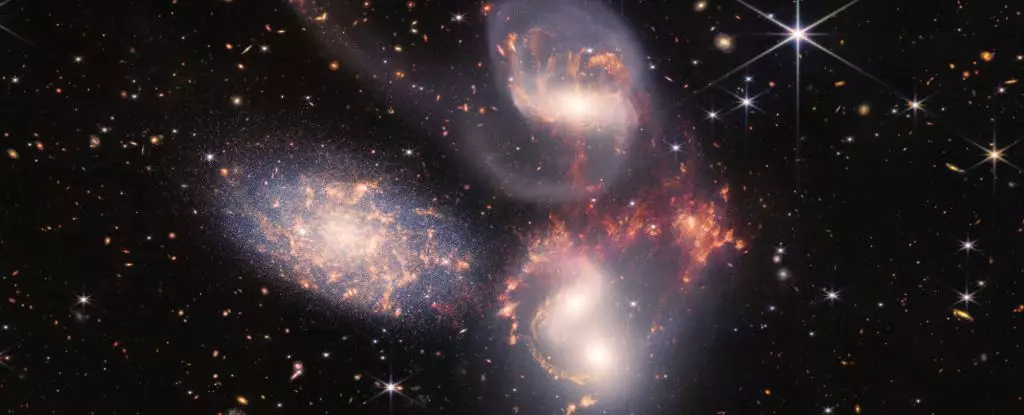At a stunning distance of 290 million light-years from our home planet, a cosmic spectacle unfolds in the grand tapestry of the universe. Stephan’s Quintet, an ensemble of four galaxies engaged in a tumultuous gravitational ballet, offers astronomers a rare glimpse into the chaos of galactic interactions. This galactic group captivates not only through its sheer scale but also through the profound insights it provides into cosmic evolution. Recent observations have unveiled intricate details of this celestial frenzy, shining a light on the dynamics that govern the formation and growth of galaxies.
Stephan’s Quintet, composed of four interacting galaxies, has been a focal point for researchers since its discovery in 1877. The ensemble is punctuated by the presence of a fifth galaxy, which, though visually clustered, is merely an optical illusion aligned along the same line of sight. This misfit gives rise to a fascinating narrative: a cosmic unity formed amid disparities of distance and gravitational ties. The chaotic interplay among the four main galaxies is driven by their gravitational attraction, propelling them into collisions that sculpt their identities and structure.
At the heart of this celestial drama is NGC 7318b, a galaxy barreling through its companions with unprecedented ferocity. Traveling at a staggering speed of 3.2 million kilometers per hour (or roughly 2 million miles per hour), this galaxy acts as a cosmic wrecking ball, imparting tremendous energy and disrupting the existing balance among the group. This monumental collision gives rise to shock waves that reverberate through the intergalactic medium—energy bursts that are akin to sonic booms generated by fast-moving jets.
Astrophysicist Marina Arnaudova from the University of Hertfordshire has emphasized that this event is not just a spectacular display, but a key to understanding the underlying processes of galaxy evolution. The shock waves stirred by NGC 7318b ignite a cascading reaction, invigorating a cloud of gas that serves as both a conduit and a battleground for energy exchange. These interactions yield vital clues about the formation of massive galaxies, illustrating how gravitational forces play a critical role in galactic mergers and growth.
Recent observations conducted using the state-of-the-art William Herschel Telescope Enhanced Area Velocity Explorer (WEAVE) have brought to light unparalleled details about the aftermath of these galactic collisions. This innovative instrument captures spectral data that enables astronomers to scrutinize the motion of gases within Stephan’s Quintet with meticulous precision. In its inaugural findings, WEAVE has illuminated the intricate dynamics of the shock front created by NGC 7318b, revealing a feature of astonishing size that far exceeds that of our own Milky Way galaxy.
One striking discovery lies in the dual nature of the gas behind the shock front. As NGC 7318b engulfs cooler regions of the gas cloud, the shock travels at hypersonic speeds, stripping electrons from atoms and generating a luminous trail of ionized gas. Conversely, as the shock pushes through warmer gas, it dissipates energy, leading to a compression that emits lower frequency radiation detectable by advanced radio telescopes like the LOFAR array. These differing interactions highlight the complexity of energy distribution in this harsh interstellar environment.
The significance of studying Stephan’s Quintet extends beyond mere scientific curiosity. Understanding such a complex interplay of galaxies provides researchers with key insights into the processes that underlie galaxy formation. The current research indicates that this kind of galactic collision plays a pivotal role in the evolution of massive galaxies, contributing to the cosmic web that characterizes our universe.
As scientists analyze the results obtained by WEAVE, they begin to uncover a wealth of information that reflects the potential for discovery through new technologies. With each revelation, they draw closer to understanding the energetic cycles governing not only Stephan’s Quintet but also the evolution of galaxies akin to our Milky Way.
Stephan’s Quintet stands as a dynamic theater of cosmic interaction. The intricate processes occurring within this galaxy group invite ongoing exploration and analysis, keeping the curiosity of the astrophysics community alive. As new technologies such as WEAVE open up fresh avenues of inquiry, our understanding of the universe and our place within it continues to expand, illuminating the path of cosmic discovery for generations to come.


Leave a Reply